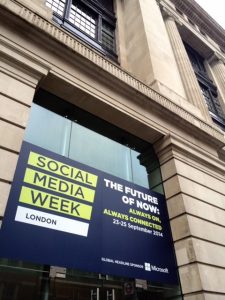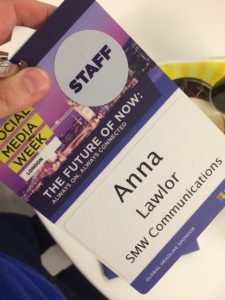What I learned from Social Media Week London 2014
- All Categories
- Awards
- News
- Press
Categories
Social Media Week London is a gathering of the ‘Great and Good’ of social media marketing and community management.
On behalf of Luminescence, I attended the event as a guest blogger, covering some of the headline seminars at the event HQ in Bloomsbury, London on 25 September 2014.
To kick-off the week, I wrote a behind-the-scenes article for The Guardian, revealing how Social Media Week London approaches its own social media strategy, and which digital marketing platform it found invaluable (you’ll never guess the answer).
Here’s what I learned from Social Media Week London:
 Wearable tech is not a fad – it will be commonplace within five years
Wearable tech is not a fad – it will be commonplace within five years
This isn’t hype; the technology is there and so is the consumer demand if fashion, design and style are allowed to take centre stage with the tech operating seamlessly in the background.
Kei Shimada, a Japanese American entrepreneur specialising in wearable technology, provided a rich seam of examples where wearables not only fulfilled a tech-enabled function (like glasses that record video and audio, or clothing that automatically moderates the wearers body temperature) but that actually look like attractive fashion people would wear today.
I was particularly taken by designs from companies that originated in fashion and bought-in the tech element, rather than technology companies (like Google or Samsung) trying to create a fashion product.
Wearable tech examples that convinced me:
- Kairos – mechanical smart watch hybrid (check out the video here)
- Jins Memes glasses – smartphone-linked glasses that can tell whether you are tired
- OM Signal – biometric smartwear that monitors, records and responds to the wearer’s physical responses. Ideal for exercise clothing
- Nymi – biometric band that uses the wearer’s “unique cardiac rhythm” to identify them and act as a wearable key for multiple scenarios
Businesses seem to think wearable tech is the domain of geeks and (Google Glass wearers) ‘Glassholes’, so futuristic as to be irrelevant to today’s business leaders.
Considering the swift rise of social media (roughly 10 years old now) and internet-connected smartphones (the first iPhone launched seven years ago), ignore wearable technology and its potential disruptive risks and opportunities for your business at your peril.
Consumer psychology is increasingly important to understand digital buying behaviour
The best seminar I attended – by far – was Toby Daniels, Founder and CEO of Social Media Week, in conversation with Rory Sutherland, Vice Chairman of advertising/communications giants Ogilvy & Mather. Read my blog on Rory Sutherland’s Social Media Week session, here.
Rory Sutherland gave fantastic, practical examples of how marketers can ‘nudge’ consumer behaviour both online and offline by applying even rudimentary understanding of social psychology. From how to discount on eCommerce websites through to how restaurants use psychological social nudges about wine purchases (their product with the greatest price mark-up).
Viral social media examples and case studies are disingenuous
Okay, what do I mean by this? At several seminars I heard convincing viral social media examples that were then applied to business of all sizes. The presenters asserted that even a start up business could attain viral social media success so long as they got all of the basics right, like not just broadcasting but building a community, being “authentic” online and delivering a strong brand promise.
I’m unconvinced.
One example was the viral social media success of an impromptu Twitter campaign: #PizzaOnATrain. British comedian Chris Ramsey (pictured above) challenged Domino’s to deliver pizzas to the passengers on his carriage, traveling on an East Coast train from London Kings Cross to Newcastle.
While #pizzaonatrain was the biggest trending topic worldwide for several hours, with 11,937 Twitter users getting involved, I would argue this type of viral Twitter campaign was only possible because of the huge influence Chris Ramsey already had (290,000 Twitter followers). A start-up with a few hundred Twitter followers would unlikely have had the PR-inducing support of comedians David Mitchell and Sarah Millican, each with their substantial Twitter influence.
We already know that some brands are delivering preferential treatment to (potential) customers it consider to have high social media influence; read this article I wrote for The Guardian – Attack of the Social Poachers. This could have also influenced how bothered Domino’s was to embrace the challenge.
This example was given by Sarah Drinkwater from Google Campus – read my Social Media Week blog of her Storytelling seminar here.
My takeaway from this is – be sceptical. Sometimes people do not want critical reality to get in the way of a good story, a good anecdote.
Their desire to make social media accessible to ALL businesses can be a victim of this, even if MUCH of what is said and many of the good social media practice tips and guidance are valid for a huge swathe of businesses.
Some good insights into how content goes viral on social media is from Wharton Business School Professor, Jonah Berger. I commissioned him to write this article – The DNA of Viral Content – for a series published on The Guardian.
Luminescence interviewed the executive director of Social Media Week London for The Social Media Show podcast. Sign up to our mailing list to ensure you don’t miss it when it’s broadcast.
Anna Lawlor is a journalist, content creator and co-director of Luminescence. Follow her on Twitter: @Little_Lawlor or @HiLuminescence











